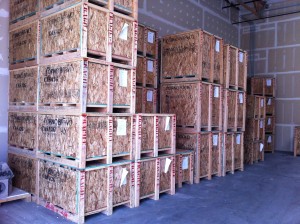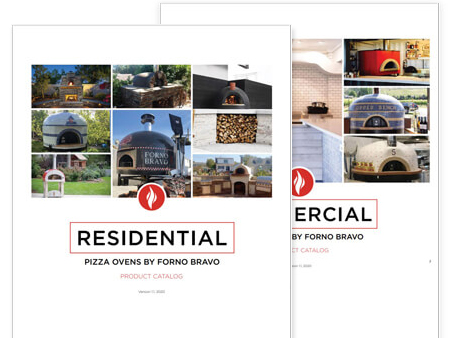How Do You Price a Pizza Oven?
Apr 13, 2012Posted by Forno BravoAs a manufacturer and retailer, how do we price your products?
It’s an interesting question and there are a number of different issues that come into play. As I wrote earlier, I believe that a higher degree of business transparency is an appropriate strategy in the Internet age, and it occurred to me that sharing our pricing strategy would make sense—both for us and for our customers.
If you have done research into pizza oven pricing recently, you will have noticed that the Forno Bravo ovens include all of the installation equipment (all of the insulation, mortar, and the chimney), while our competitors force you to buy all of those essential items as costly extras—AND, you will have seen that our ovens cost a lot less than our competitors. A Forno Bravo residential pizza oven typically costs between $1,000 and $1,500 less than the “other guys” including shipping. That is a very high cost saving compared with the overall cost of a typical residential oven.
We believe that we are the “category killer” in our market. According to Wikipedia:
Category killer is a term used in marketing and strategic management to describe a product, service, brand, or company that has such a distinct sustainable competitive advantage that competing firms find it almost impossible to operate profitably in that industry (or in the same local area).
You might be wondering—how can Forno Bravo do it?
There are a couple of good reasons. First, as a manufacturer, we purchase large quantities of the highest quality, but very low integration level, raw materials—directly from the original manufacturer. Think calcined aggregates, calcium aluminate, and polypropylene fibers. Our raw material costs are a lot lower than our competitors who import ovens from Europe or buy their products from contract manufacturers. Second, we actually make our own products—in the USA. We do not purchase items in Euros and we do not have to pay for costly container shipping. Don’t forget that pizza ovens are very heavy and are difficult to safely ship—you need to ship the ovens from a city in Italy where they are made to the port by truck; from the Italian port to a US port by sea; through customs; and from the US port to the importer’s warehouse by truck. You don’t need to know the exact numbers (though of course as a former importer we do) to know that there is a very high “per oven” cost to simply ship the oven from the European manufacturer to California.
And finally, we are the highest unit volume pizza oven manufacturer and seller (probably by a very large margin) in the US. This brings a number of benefits to you—the consumer or dealer installing the oven. Our high unit volumes drive up our efficiency and they drive down our manufacturing costs. Also, because we are selling lots of ovens, we do not need to make as large a profit on each oven as we would if we were selling a much smaller number.
I am still struck by the fact that one of our competitors was selling a small, low-end 32” oven, without insulation, mortar or the chimney, for $2,750 when we first founded Forno Bravo. Clearly they were not selling very many of them, and they needed to make a big profit from each one. Today, we sell a higher quality 32” oven, with all of the installation equipment, for $1,850.
The best external model to describe our pricing strategy for our ovens is the Apple iPad. Because of their high volumes and innovative design, Apple is able to sell a product that is both better and less expensive than their competitors. So much so that they have scared many of their competitors completely out of the market.
We believe that Forno Bravo sells ovens that are significantly better than our competitors in terms of design and quality of materials; that our ovens are much more complete than our competitors because they include the things that you always need to install your oven; at a price that is significantly lower than our competitors. That is one of the reasons Forno Bravo has been so successful and has expanded so significantly in recent years.
There is one other similarity between a Forno Bravo oven and the iPad. Both have a straightforward, fixed retail price. You can buy a Forno Bravo from one of our dealers, from the Forno Bravo Store, or by calling our sales department (800-407-5119)—and it will cost the same no matter where you buy it. Sometimes it can be fun, or worth it, putting a lot of time into doing price comparisons for different merchants selling the same product, but in the case of pizza ovens, there are so many fun details to work on (design, installation, the rest of your kitchen, and making great pizza dough)—we wanted to make buying the oven itself easy.
But what about shipping and packaging costs? I see that you charge for shipping.
There are some interesting models out there that you can examine in terms of shipping costs. On one extreme, take Amazon as an example. They charge consumers a flat $75 fee to qualify for the Prime status, and everything is shipped for free, 2nd-day delivery. For many commodity items, this model provides the consumer with good value, while, for Amazon, it has played a big role in their emergence as the nation’s dominant online retailer. At the same time, Amazon loses billions of dollars on shipping each year, that they then make up with huge sales volumes. Like many retailers (including Costco), they operate on very tight margins and make very little profit on each item (in fact they lose money on many items they sell)—but it all comes out in the wash. Heck, Jeff Bezos, the Amazon founder is worth about $18B, so it’s fair to say they’ve made some aggressive moves that have worked out well.
On the other extreme, you see small merchants on eBay (and sadly on TV Infomercials) who sell their product at a low prices (perhaps below cost), or even for free—but who charge very high shipping and handling fees. Which, in part, led to eBay’s practice is listing the “cost” for an item as the item cost + shipping cost. All of which makes a lot of sense.
As a manufacturer and retailer (we produce ovens and sell them), we have made the decision to charge the actual cost of shipping and packaging, based on the size and weight of the oven and the distance of the customer location for our factory, as one of our pricing cornerstones. There are a coupe of good reasons for this.
First, we do not build the cost of shipping and packaging into the price of our ovens. We have a reasonable number of customers who pick-up their oven directly from us at the factory, and it does not seem fair to make those customers implicitly pay for shipping and packaging that they are not using. We also charge shipping according to the customer’s location, rather than charging a flat fee nationwide. Again, it does not seem fair to charge someone in Northern California the same cost to ship an oven, as we charge someone very far away.
Beyond these practical issues, this strategy underscores a philosophical underpinning. We believe that the company should charge a fair price for our ovens and that we should make our profit on actually selling ovens in the marketplace—and that the amount we charge for shipping and packaging should simply offset our actual costs. We ship a lot of ovens, and we get very good freight rates, and we pass these low rates on to our customers. So when you get a quote from Forno Bravo using the FastQuote system, you are seeing the actual cost of shipping.
Which leads me to the idea of charging a crate fee. I know that lots of us get tired of seeing the litany of small fees that the phone companies, airlines, and shipping company keep filing on. Airport fees, fuel surcharges, luggage fees, access fees, etc. As the comedians ask—how are are we from toilet fees on airplanes? But our crating fee is different; because it’s real. In order to get one of our wonderful pizza ovens to you in perfect shape, we build a really, really well-designed and well-built wooden crate. It has a ton of wood, bracing, straps, wrap and foam, and we use a very well proven method for stacking and strapping all of the oven pieces in place inside the crate. Everything in its place, in just the right order. My point is that all of this costs real money; in fact, plywood is one of our largest single expenses (who would have thought).

Staging crates for export via container ship.
Which takes me back to why we have to charge a crate fee. I think it would be unfair to customers picking up ovens and who do not need the crate, to have that cost built into the oven price.





